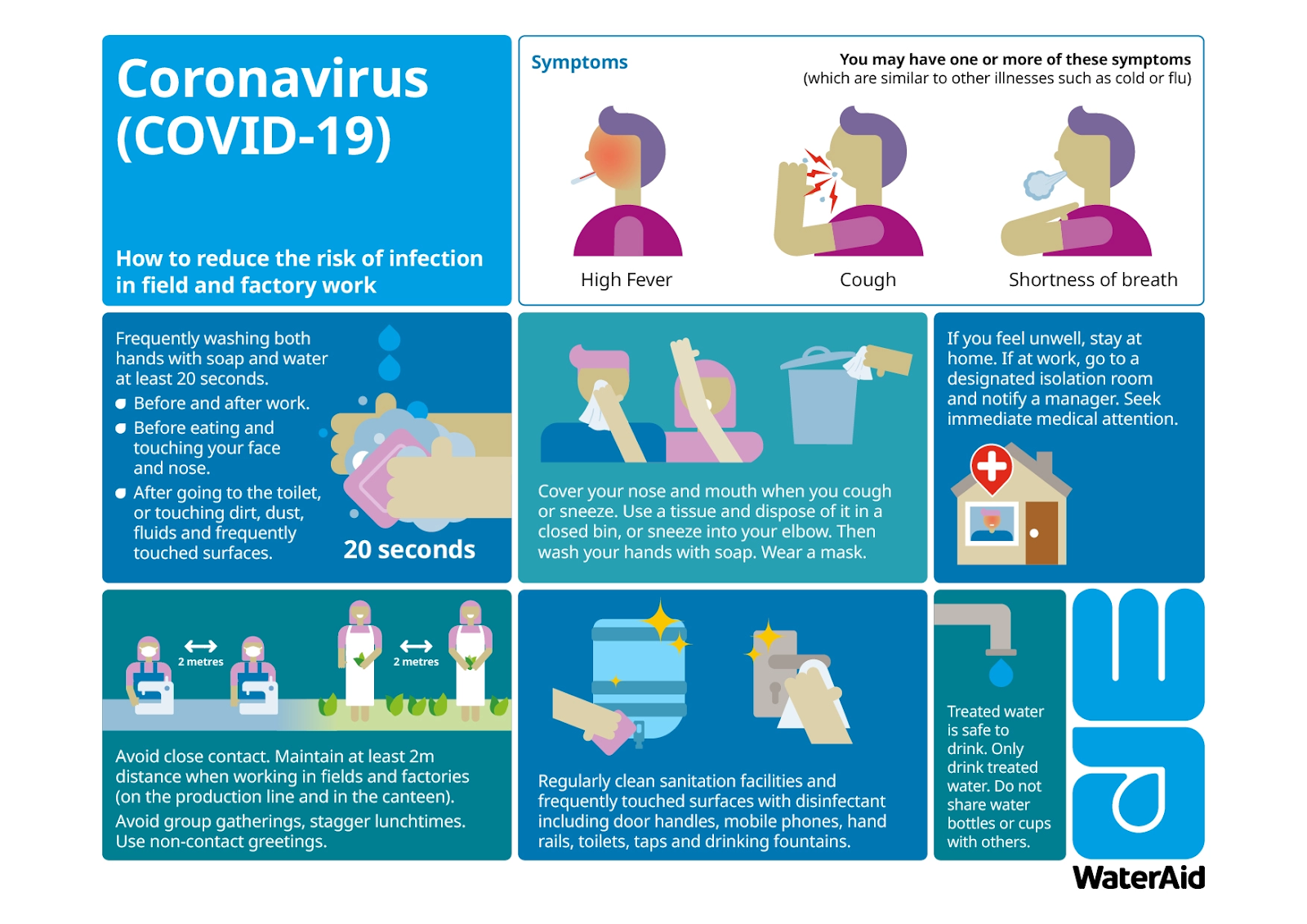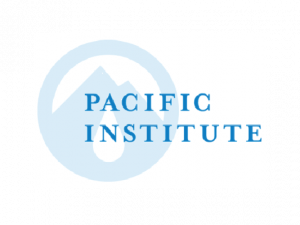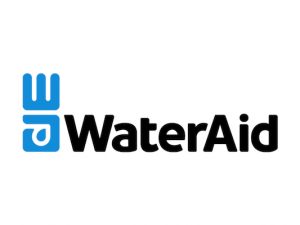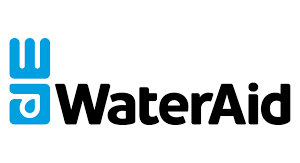Reopen your business; keep employees, communities, and suppliers safe and healthy
Before implementing any solutions, companies must first understand the key risk points for exposing their employees to COVID-19 and other threats resulting from the shuttering of their operations in recent months. Ideally, such an assessment is conducted as early as possible, identifies and prioritizes a company’s COVID-19 risks as they pertain to water and handwashing, and defines strategic solutions that effectively and efficiently manage those risks.
Risk identification will benefit from the completion of a Hazard Analysis in Critical Control Points (HACCP). The HACCP process can help identify opportunities for the virus to be contracted across various business settings, map out key points of exposure, and determine helpful mitigation actions. While such processes are typically employed for food safety, they can be contextualized for use on the water- and handwashing-related elements of COVID-19. NGOs such as WaterAid and others are available to help businesses and other organizations design relevant HACCP assessments across a variety of contexts and circumstances.
Strategic solutions should comprise both hardware (i.e., physical interventions such as new handwashing stations, signage, etc.) and software (i.e., training programs, protocols, etc.). Specific interventions are discussed more in depth below.
Practical Actions
- Conduct HACCP to identify risks
- Identify and prioritize strategic solutions, including software and hardware
- Work with WASH NGOs to support self-assessment process
As society begins to reemerge from quarantines, stay-at-home orders, and business shutdowns during the pandemic, attention must be paid to the potential health risks associated with stagnant water inside building plumbing. Under normal conditions, the regular flow of community tap water into and through building water systems minimizes the amount of bacteria and metals that build up in water. However, even after a short period of shutdown, stagnant water can pose risks to health if not carefully managed.
As such, if their facilities have been shut down, businesses should methodically restart the flow of water through their manufacturing operations, offices, and retail facilities to ensure the water is safe for people to drink and does not adversely affect any operations that require high-quality water.
NOTE: Available data and analysis do not provide any evidence that COVID-19 spreads more easily through water. As such, businesses where many employees work in or around large volumes of water are not currently believed to be at heightened risk of contracting the virus, relative to other types of businesses.
Practical Actions
- If possible, during a shutdown, facilities should maintain a minimum flow of water through the system.
- Contact your water utility to see if specific information is available for your system.
- To prevent bacterial growth, particularly Legionella, heat hot water to at least 140 degrees F (60 degrees C) and make sure it stays hot, greater than 131 degrees F (55 degrees C) at points of use.
- In buildings where water was stagnant for an extended period, flush both the cold and hot water piping and water storage. First flush the cold water and then the hot water at all points of use (faucets, showers, toilets, etc.) and in all water-using devices (dishwashers, washing machine, ice makers, etc.), with special attention to water outlets where exposure to contaminants is likely (showerheads, spas, etc.). Be careful to bypass point-of-use treatment devices during flushing and maintain those devices per manufacturer instructions.
Example
Facilities Management of Colorado State University maintains water flowing through the pipes of unoccupied buildings by regularly running faucets and flushing toilets. This ensures that the water remains safe to drink. Meanwhile, for buildings that usually serve large numbers of people and have extensive plumbing systems, it is impractical to continuously flush water through the pipes. CSU has posted signs on such buildings indicating that the water is not safe to drink and will flush the system upon reopening.
Water and handwashing at the workplace are critical elements of preventing the transmission of the virus regardless of the nature of the business or the type of facility. By washing hands thoroughly (and refraining from touching their face with their hands), workers can drastically reduce the likelihood of being infected or spreading the virus. This practice is both critically important at the workplace — in agricultural, manufacturing, and office settings — and at home. If workers do not wash hands properly at home, they increase the likelihood of contracting the disease and spreading it to co-workers once they return to work.
Often, a lack of awareness on how to wash hands effectively or the possible repercussions of not doing so is a key barrier to effective handwashing. Therefore, actions to educate employees on proper handwashing techniques are not only an ethical imperative, but critical for businesses’ ability to operate. If many employees become ill due to COVID-19 (or are caring for loved ones who are sick at home), the business will lose many productive hours due to absenteeism.
Effective WASH training programs make use of existing materials wherever possible. Companies can therefore build off of and expand their own existing processes, trainings, or procedures or make use of existing educational resources, such as the WaterAid infographic below. Many countries will also have national education campaigns the company can integrate into its own programs and messaging.
Training programs should leverage a number of different educational and communication approaches, including audio and visual materials, social media outreach, experiential learning and demonstrations, and more. Leaflets and brochures alone are typically largely ineffective at achieving lasting behavior change. The messages across these different approaches should be comprehensive, consistent, and as concise as possible.
There is no one-size-fits-all approach for WASH messaging. Different companies will require different messages, processes, and approaches based on their own unique circumstances.
Practical Actions
- Collaborate with WASH NGO partners to conduct trainings on proper handwashing as well as the consequences of inadequate handwashing.
- Distribute educational leaflets and conduct trainings for workers and suppliers to support safe handwashing practices and other measures at the workplace and at home.
- Display banners on walls with prevention and protection advice.
- Develop and disseminate multimedia approaches, including audio materials (e.g. podcast), jingles in restrooms, visual materials (e.g., YouTube video training), infographics, and more.
Example
L’Oréal has developed an e-learning module called #SafeTogether that updates employees on the L’Oréal Group’s workplace hygiene and health protocols, including best handwashing practices. L’Oréal requires its employees to take the module, available in 14 languages, before returning to work. Over 14,000 employees have already sucessfully completed the course. L’Oréal has made a version of the module available publicly via CrossKnowledge, a digital learning company, where it can be used by CrossKnowledge’s 500 corporate clients.
Featured resources

-
Prioritising Hygiene for Business Resilience: Enabling Safe Return to Work for Global Supply Chain Employees in the Face of COVID-19 – WaterAidRead more
Aimed at a business audience, the guidance explains the interdependent nature of workforce health and business resilience, never more critical than in the face of COVID-19. In it we suggest an…
Overview
Beyond educating workers on using handwashing facilities properly, businesses must also ensure that proper handwashing facilities and access to clean drinking water are consistently available in the places where they are most likely to be needed. Further, they should develop and adopt protocols that ensure these facilities are regularly cleaned, maintained, and kept operational. Generally speaking, access to handwashing and drinking water is lower in middle- and low-income countries. A map of national statistics on access to hygiene can be found here (select 6.2.1b from the column on the left).
Businesses have the greatest ability to implement such measures at their owned-and-operated facilities. However, they are still exposed to considerable risk due to improper practices at workers’ homes and among suppliers. As such, where possible, businesses should use their influence and financial resources to encourage and facilitate the implementation of such practices in homes and among suppliers. For workers’ homes, this can be accomplished through partnerships with local WASH NGOs or by supporting local government WASH activities. For suppliers, especially those that are less likely to have access to financial resources, businesses can consider investing in proper handwashing facilities, alcohol-based hand rubs, and/or access to clean drinking water in order to help ensure a consistent flow of critical supplies.
Practical Actions
- Ensure the consistent availability and maintenance of handwashing facilities with soap. Hand-washing facilities should be located near areas that are critical for hand washing (e.g. toilets, health clinic facilities, building entrances, meeting areas, cafeterias/canteens).
- Ensure the consistent availability of clean drinking water throughout the workplace.
- Regularly clean and maintain drinking water, sanitation, and hygiene facilities.
- Make available alcohol-based hand rubs (minimum 60 per cent alcohol) and strongly encourage their use where hand-washing facilities are not available.
- Encourage and facilitate suppliers’ implementation of proper handwashing facilities and protocols.
- Donate to local WASH NGOs that can help offer WASH access at workers’ homes where needed.
- Donate hygiene supplies to employees, frontline workers, and local communities.
Overview
Some, but not all, businesses have operations that can be converted to develop products and/or services that support COVID-19 response. This is most commonly found among breweries, distilleries, chemical manufacturers, and producers of household goods that can convert their core operations to produce hand sanitizer. Other businesses may already be producing helpful items like soap or bottled water and can re-focus and amplify their production of those products.
Practical Actions
- Convert applicable business operations from regular products to hand sanitizers, soaps, etc.
- Accelerate production of existing products
- Re-focus water-related product delivery (e.g., water services or bottled water) to at-risk communities
Overview
Some, but not all, businesses have operations that can be converted to develop products and/or services that support COVID-19 response. This is most commonly found among breweries, distilleries, chemical manufacturers, and producers of household goods that can convert their core operations to produce hand sanitizer. Other businesses may already be producing helpful items like soap or bottled water and can re-focus and amplify their production of those products.
Practical Actions
- Convert applicable business operations from regular products to hand sanitizers, soaps, etc.
- Accelerate production of existing products
- Re-focus water-related product delivery (e.g., water services or bottled water) to at-risk communities
Invest in practices that both advance water stewardship and boost the economy
Prepare for and prevent future crises




